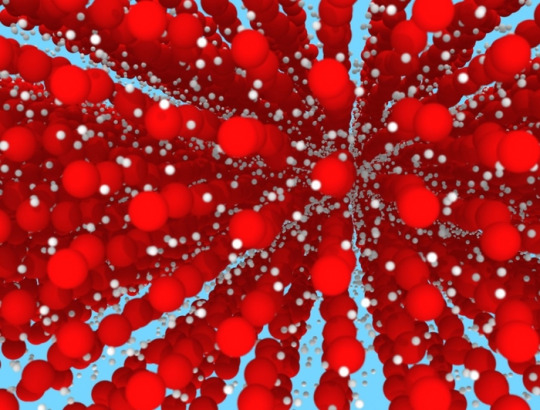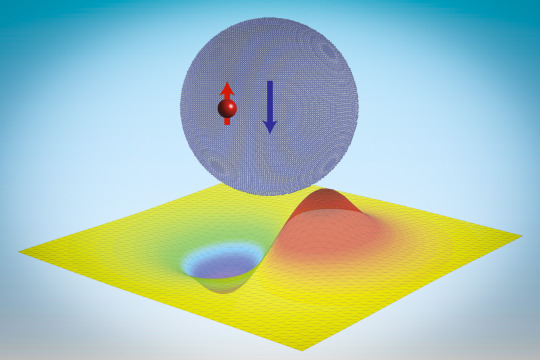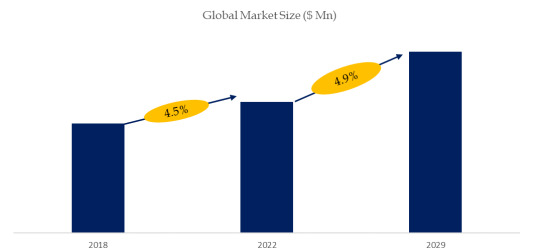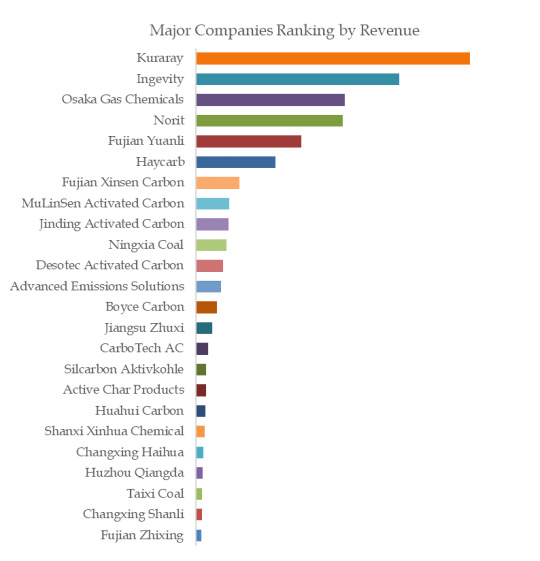#Structural electronics research reports
Text
In an experiment akin to stop-motion photography, scientists have isolated the energetic movement of an electron while "freezing" the motion of the much larger atom it orbits in a sample of liquid water.
The findings, reported today in the journal Science, provide a new window into the electronic structure of molecules in the liquid phase on a timescale previously unattainable with X-rays. The new technique reveals the immediate electronic response when a target is hit with an X-ray, an important step in understanding the effects of radiation exposure on objects and people.
"The chemical reactions induced by radiation that we want to study are the result of the electronic response of the target that happens on the attosecond timescale," said Linda Young, a senior author of the research and Distinguished Fellow at Argonne National Laboratory. "Until now radiation chemists could only resolve events at the picosecond timescale, a million times slower than an attosecond. It's kind of like saying 'I was born and then I died.' You'd like to know what happens in between. That's what we are now able to do."
Read more.
14 notes
·
View notes
Photo



Exotic water ice contributes to understanding of magnetic anomalies on Neptune and Uranus Ordinary everyday ice, like the ice produced by a fridge, is known to scientists as hexagonal ice (ice Ih), and is not the only crystalline phase of water. More than 20 different phases are possible. One of them, called “superionic ice” or “ice XVIII”, is of particular interest, among other reasons, because it is thought to make up a large part of Neptune and Uranus, planets frequently referred to as “ice giants”. In the superionic crystalline phase, water loses its molecular identity (H2O): negative oxygen ions (O2-) crystallize into an extensive lattice, and protons in the form of positive hydrogen ions (H+) form a liquid that floats around freely within the oxygen lattice. “The situation can be compared to a metal conductor such as copper, with the big difference that positive ions form the crystal lattice in the metal, and electrons bearing a negative charge are free to wander around the lattice,” said Maurice de Koning, a professor at the State University of Campinas’s Gleb Wataghin Physics Institute (IFGW-UNICAMP) in São Paulo state, Brazil. De Koning led the study that resulted in an article published in Proceedings of the National Academy of Sciences of the United States of America (PNAS) and featured on the cover of its November 8, 2022 issue. Superionic ice forms at extremely high temperatures in the range of 5,000 kelvins (4,700 °C) and pressure of around 340 gigapascals, or over 3.3 million times Earth’s standard atmospheric pressure, he explained. It is therefore impossible for stable superionic ice to exist on our planet. It can exist on Neptune and Uranus, however. In fact, scientists are confident that large amounts of ice XVIII lurk deep in their mantles, thanks to the pressure resulting from these giants’ huge gravitational fields, as confirmed by seismographic readings. “The electricity conducted by the protons through the oxygen lattice relates closely to the question of why the axis of the magnetic field doesn’t coincide with the rotation axis in these planets. They’re significantly misaligned, in fact,” De Koning said. Measurements made by the space probe Voyager 2, which flew by these distant planets on its journey to the edge of the Solar System and beyond, show that the axes of Neptune’s and Uranus’s magnetic fields form angles of 47 degrees and 59 degrees with their respective rotation axes. Experiments and simulations On Earth, an experiment reported in Nature in 2019 succeeded in producing a tiny amount of ice XVIII for 1 nanosecond (a billionth of a second), after which the material disintegrated. The researchers used laser-driven shock waves to compress and heat liquid water. According to the paper in Nature, six high-power laser beams were fired in a temporally tailored sequence to compress a thin water layer encapsulated between two diamond surfaces. The shock waves reverberated between the two stiff diamonds to achieve a homogeneous compression of the water layer resulting in the superionic crystalline phase for an extremely short time. “In this latest study, we didn’t perform a real physical experiment but used computer simulations to investigate the mechanical properties of ice XVIII and find out how its deformations influence the phenomena seen to occur on Neptune and Uranus,” De Koning said. A key aspect of the study was the deployment of density functional theory (DFT), a method derived from quantum mechanics and used in solid-state physics to resolve complex crystalline structures. “First of all, we investigated the mechanical behavior of a flawless phase, which doesn’t exist in the real world. We then added defects to see what kinds of macroscopic deformations resulted,” he explained. Crystal defects are typically point defects characterized by ion vacancies or intrusion of ions from other materials into the crystal lattice. Not so in this case. De Koning was referring to linear defects known as “dislocations”, which are due to angular differences between adjacent layers resulting in puckering somewhat like a rumpled rug. “In crystal physics, dislocation was postulated in 1934 but first observed experimentally in 1956. It’s a type of defect that explains a great many phenomena. We say dislocation is to metallurgy what DNA is to genetics,” De Koning said. In the case of superionic ice, the sum of dislocations produces shear, a macroscopic deformation familiar to mineralogists, metallurgists and engineers. “In our study, we calculated, among other things, how much it’s necessary to force the crystal for it to break up owing to shear,” De Konig said. To this end, the researchers had to consider a relatively large cell of the material with about 80,000 molecules. The calculations entailed extremely heavy and sophisticated computational techniques, including neural networks, machine learning, and the composition of various configurations based on DFT. “This was a most interesting aspect of the study, integrating knowledge in metallurgy, planetology, quantum mechanics and high-performance computing,” he said.
43 notes
·
View notes
Text
Batch 2024 participates in 2-week off-campus internship
University of the Philippines Integrated School (UPIS) Batch 2024 completed their 2-week off-campus internship at various sites from February 12 to 23.
Part of the Grade 12 work program is the two-week off-campus internship which aims to apply the knowledge and skills they have obtained from Kindergarten to Grade 11, to experience a real-world work environment, to understand and explore the careers they may pursue in the future, and to develop proper attitudes regarding leadership structure, employee interactions, and professionalism.
Social Sciences and Humanities (SSH) Track
Grade 12 - Kalayaan, the Social Sciences and Humanities (SSH) track, had their work immersions at Bantayog ng mga Bayani Foundation, Interactive Children’s Literacy Program (ICLiP), M&P Creatives, and Teatrong Mulat ng Pilipinas. UP Diliman Information Office (DIO) and DZUP 1602, despite being within the UP campus, were also included as internship sites for the off-campus work immersion.
The sites offered internship tasks such as writing articles, creating scripts, designing social media posts and publicity materials, covering events, newscasting, hosting, observing and teaching classes, assisting video shoots, joining rehearsals, and participating in activities conducted by the sites.
Zaeda Wadi, a former UPDIO intern, shared some of the most important lessons she learned through her internship. “At the UP DIO, I learned that being attentive is such a helpful asset to have! Be it in article-writing, observing during programs, interacting with others, or following instructions, having a present mind makes things clearer—and easier. I also realized that there are various activities in UP Diliman that I can participate in! It opened more doors for me to venture that can set me on new experiences as a student and community member,” she stated.
Additionally, she talked about some of the discoveries she made through UP DIO. “UP DIO staff taught me that in the hustle of life, sharing conversations and laughs makes the office life bearable and memorable! I learned from their close bond how it is always nice, even essential, to check in daily wholesome chats with people we meet at the workplace,“ she shared.



Business and Entrepreneurship (BE) Track
Grade 12 - Kapayapaan, the Business and Entrepreneurship (BE) track, experienced working at Underdog Fitness PH, Revised Salon, Friuli Trattoria, Puff & Dough BakeLab, SGD Coffee, Street Kohi, Noki Japanese Fried Chicken, and Urban Chick for their off-campus internship.
Some of their work included taking orders from customers, cleaning and setting up the area, making orders and food products for the business, assisting in supply inventory, creating and designing social media posts, preparing financial reports, assisting in administrative-related tasks, and conducting market research.
Princess Tan, a former intern at Noki Japanese Fried Chicken, shared her thoughts on how different the off-campus internship is from completing regular coursework for classes. “The real world is less structured than the system in school. The tasks we had to do weren’t listed for us and weren’t taught to us from the very start to end. You are expected to learn the operations as you go through the work program. Additionally, mistakes would cost you more unlike in school where you’ll just get a deduction on your score,“ she said.



Applied Sciences and Engineering (ASE) Track
Grade 12 - Karangalan and Karunungan, the Applied Sciences and Engineering (ASE) track, held their internship programs at Ateneo de Manila University (ADMU) - Department of Information Systems and Computer Science (DISCS), ADMU - Department of Electronics, Computer, and Communications Engineering (ECCE), ADMU - Department of Mathematics, Buri Technologies, Department of Environment and Natural Resources (DENR) - Environmental Management Bureau (EMB), DENR - Mines and Geosciences Bureau (MGB), Department of Information and Communications Technology (DICT), Department of Science and Technology (DOST) - Advanced Science and Technology Institute (ASTI), DOST - Philippine Atmospheric, Geophysical, and Astronomical Services Administration (PAGASA), LCI Envi Corporation, New Era General Hospital, Smile Studio Dental, and Wilson Hobby Studio.
Some specific tasks given by the sites consisted of conducting playtests, exploring and programming with Artificial Intelligence (AI), attending workshops and seminars, testing websites, creating courses on websites, performing Test Case Documentation, listing products and packaging of companies, managing and operating with information and cybersecurity, weather research and reporting, assisting in dental-related work, input and documentation of dental procedures and prices, assisting in tech support with 2D software, 3D printing, and attending discussions and seminars held by the sites.
Enjoce Lampa, a former intern at ADMU - Department of Information Systems and Computer Science (DISCS), shared the skills he was able to develop or enhance through his experience. “The skill I used the most during the internship was definitely my knowledge in programming. I think I already had pretty good programming [or] coding knowledge from my experiences but this internship further enhanced my skills because I was able to use it on a real project. I learned the Godot game engine and its native language, GDScript, to create our game and I think I will be using this knowledge more in the future,“ he stated.


Batch 2024 is the first batch of Grade 12 students to experience separate cycles for their off-campus and on-campus internship since the pandemic. Last year, they finished their on-campus internship, which lasted from December 4 to 15. //by Mira Leaño and Ria Bautista
4 notes
·
View notes
Text
MIT researchers discover “neutronic molecules”
New Post has been published on https://thedigitalinsider.com/mit-researchers-discover-neutronic-molecules/
MIT researchers discover “neutronic molecules”


Neutrons are subatomic particles that have no electric charge, unlike protons and electrons. That means that while the electromagnetic force is responsible for most of the interactions between radiation and materials, neutrons are essentially immune to that force.
Instead, neutrons are held together inside an atom’s nucleus solely by something called the strong force, one of the four fundamental forces of nature. As its name implies, the force is indeed very strong, but only at very close range — it drops off so rapidly as to be negligible beyond 1/10,000 the size of an atom. But now, researchers at MIT have found that neutrons can actually be made to cling to particles called quantum dots, which are made up of tens of thousands of atomic nuclei, held there just by the strong force.
The new finding may lead to useful new tools for probing the basic properties of materials at the quantum level, including those arising from the strong force, as well as exploring new kinds of quantum information processing devices. The work is reported this week in the journal ACS Nano, in a paper by MIT graduate students Hao Tang and Guoqing Wang and MIT professors Ju Li and Paola Cappellaro of the Department of Nuclear Science and Engineering.
Neutrons are widely used to probe material properties using a method called neutron scattering, in which a beam of neutrons is focused on a sample, and the neutrons that bounce off the material’s atoms can be detected to reveal the material’s internal structure and dynamics.
But until this new work, nobody thought that these neutrons might actually stick to the materials they were probing. “The fact that [the neutrons] can be trapped by the materials, nobody seems to know about that,” says Li, who is also a professor of materials science and engineering. “We were surprised that this exists, and that nobody had talked about it before, among the experts we had checked with,” he says.
The reason this new finding is so surprising, Li explains, is because neutrons don’t interact with electromagnetic forces. Of the four fundamental forces, gravity and the weak force “are generally not important for materials,” he says. “Pretty much everything is electromagnetic interaction, but in this case, since the neutron doesn’t have a charge, the interaction here is through the strong interaction, and we know that is very short-range. It is effective at a range of 10 to the minus 15 power,” or one quadrillionth, of a meter.
“It’s very small, but it’s very intense,” he says of this force that holds the nuclei of atoms together. “But what’s interesting is we’ve got these many thousands of nuclei in this neutronic quantum dot, and that’s able to stabilize these bound states, which have much more diffuse wavefunctions at tens of nanometers [billionths of a meter]. These neutronic bound states in a quantum dot are actually quite akin to Thomson’s plum pudding model of an atom, after his discovery of the electron.”
It was so unexpected, Li calls it “a pretty crazy solution to a quantum mechanical problem.” The team calls the newly discovered state an artificial “neutronic molecule.”
These neutronic molecules are made from quantum dots, which are tiny crystalline particles, collections of atoms so small that their properties are governed more by the exact size and shape of the particles than by their composition. The discovery and controlled production of quantum dots were the subject of the 2023 Nobel Prize in Chemistry, awarded to MIT Professor Moungi Bawendi and two others.
“In conventional quantum dots, an electron is trapped by the electromagnetic potential created by a macroscopic number of atoms, thus its wavefunction extends to about 10 nanometers, much larger than a typical atomic radius,” says Cappellaro. “Similarly, in these nucleonic quantum dots, a single neutron can be trapped by a nanocrystal, with a size well beyond the range of the nuclear force, and display similar quantized energies.” While these energy jumps give quantum dots their colors, the neutronic quantum dots could be used for storing quantum information.
This work is based on theoretical calculations and computational simulations. “We did it analytically in two different ways, and eventually also verified it numerically,” Li says. Although the effect had never been described before, he says, in principle there’s no reason it couldn’t have been found much sooner: “Conceptually, people should have already thought about it,” he says, but as far as the team has been able to determine, nobody did.
Part of the difficulty in doing the computations is the very different scales involved: The binding energy of a neutron to the quantum dots they were attaching to is about one-trillionth that of previously known conditions where the neutron is bound to a small group of nuclei. For this work, the team used an analytical tool called Green’s function to demonstrate that the strong force was sufficient to capture neutrons with a quantum dot with a minimum radius of 13 nanometers.
Then, the researchers did detailed simulations of specific cases, such as the use of a lithium hydride nanocrystal, a material being studied as a possible storage medium for hydrogen. They showed that the binding energy of the neutrons to the nanocrystal is dependent on the exact dimensions and shape of the crystal, as well as the nuclear spin polarizations of the nuclei compared to that of the neutron. They also calculated similar effects for thin films and wires of the material as opposed to particles.
But Li says that actually creating such neutronic molecules in the lab, which among other things requires specialized equipment to maintain temperatures in the range of a few thousandths of a Kelvin above absolute zero, is something that other researchers with the appropriate expertise will have to undertake.
Li notes that “artificial atoms” made up of assemblages of atoms that share properties and can behave in many ways like a single atom have been used to probe many properties of real atoms. Similarly, he says, these artificial molecules provide “an interesting model system” that might be used to study “interesting quantum mechanical problems that one can think about,” such as whether these neutronic molecules will have a shell structure that mimics the electron shell structure of atoms.
“One possible application,” he says, “is maybe we can precisely control the neutron state. By changing the way the quantum dot oscillates, maybe we can shoot the neutron off in a particular direction.” Neutrons are powerful tools for such things as triggering both fission and fusion reactions, but so far it has been difficult to control individual neutrons. These new bound states could provide much greater degrees of control over individual neutrons, which could play a role in the development of new quantum information systems, he says.
“One idea is to use it to manipulate the neutron, and then the neutron will be able to affect other nuclear spins,” Li says. In that sense, he says, the neutronic molecule could serve as a mediator between the nuclear spins of separate nuclei — and this nuclear spin is a property that is already being used as a basic storage unit, or qubit, in developing quantum computer systems.
“The nuclear spin is like a stationary qubit, and the neutron is like a flying qubit,” he says. “That’s one potential application.” He adds that this is “quite different from electromagnetics-based quantum information processing, which is so far the dominant paradigm. So, regardless of whether it’s superconducting qubits or it’s trapped ions or nitrogen vacancy centers, most of these are based on electromagnetic interactions.” In this new system, instead, “we have neutrons and nuclear spin. We’re just starting to explore what we can do with it now.”
Another possible application, he says, is for a kind of imaging, using neutral activation analysis. “Neutron imaging complements X-ray imaging because neutrons are much more strongly interacting with light elements,” Li says. It can also be used for materials analysis, which can provide information not only about elemental composition but even about the different isotopes of those elements. “A lot of the chemical imaging and spectroscopy doesn’t tell us about the isotopes,” whereas the neutron-based method could do so, he says.
The research was supported by the U.S. Office of Naval Research.
#000#2023#Analysis#artificial#atom#atomic#atomic nuclei#atoms#Capture#chemical#chemistry#clusters#Collections#colors#Composition#computer#crystal#crystalline#development#devices#dimensions#direction#display#DMSE#dynamics#effects#electromagnetic#electron#electrons#energy
2 notes
·
View notes
Text
We've Been Robbed!
I was awakened abruptly to the sound of my roommates and other classmates down the hall of the hotel screaming “Wake up! We’ve been robbed!!!!”. Disoriented I began frantically looking around the room to see what might’ve been stolen. Most things looked as though to be in the original place. Then my roommate Saige shouted “My phone is missing!” Nick down the hall “My apple watch is gone!”. More and more similar reports began to be shouted in the air for all to hear and account for. It seemed that only electronics of value were the common theme of stolen items here. I looked around for mine but saw my phone was still safely tucked under the sheets next to me. Also my big ipad pro was still nicely propted on top of the pillow in front of me. Both roommates to my left and right had been robbed, but not me. Day 9 of the Italy trip while it being day 3 in Florence, I was feeling a little disappointed to have missed so many things thus far. I woke up still feeling very queasy so I decided to take it easy in the morning. However I was determined to have an adventure of some sort later that day. I could not let this get the best of me. Plus this was going to be our last day in Florence till we left for Venice. I started getting ready for whatever might occur. First things first, I hadn’t eaten for over 36 hours so I decided to try and find a restaurant with food that was familiar to me so I can ease my stomach back into regular eating. I did some research and found this breakfast spot called The Rooster. Slowly I made my way to it and finally had the closest thing to American food I've had. Eggs with french toast, hash browns, and a cold coffee. My appetite had not fully returned so I was barely able to finish it, but it sure tasted good! I took my journal out and started writing out some things. Then I decided to head down to the market to walk around and browse the souvenirs. While walking past the apple store I ran into 5 of my classmates inside that greeted me. Two of them had also gotten their phones stolen and were trying to locate them. A bunch of us decided to go on an adventure together to salvage the day. So we jumped on a bus and left town! We ended up in this awesome little spot from this ancient civilization that there was there even before the Romans arrived! Gorgeous old city ruins, with plenty of stones to climb, and beautiful fields of flowers to behold. There was even this small outside auditorium-like structure where people would go to speak. After our aimless wandering and exploration of the ruins we went into this little museum they have about the ancient civilization that inhabited the land long ago. It was so neat! They had these red clay vases that reminded me of the ones from Hercules! Come to find out they're the same kind of vases that were used to specifically record great battles and mythology just like in Hercules. We all grabbed dinner later then hopped on the next bus back. Some friends and I went back in town on a search to find the perfect David souvenir and then called it a night. We bargained well. It was a great day.








2 notes
·
View notes
Text
Strange hexagonal diamonds found in meteorite from another planet
https://sciencespies.com/space/strange-hexagonal-diamonds-found-in-meteorite-from-another-planet/
Strange hexagonal diamonds found in meteorite from another planet
Diamonds found in four meteorites in north-west Africa probably came from an ancient dwarf planet, and they are expected to be harder than Earth diamonds
Space
12 September 2022
By Alice Klein
Electron microscopy has revealed hexagonal diamonds (the dark area near the middle of the picture) in meteorites found in Africa
Alan Salek/RMIT
Mysterious hexagonal diamonds that don’t occur naturally on Earth have been discovered in four meteorites in north-west Africa.
“It’s really exciting because there were some people in the field who doubted whether this material even existed,” says Alan Salek at RMIT University in Melbourne, Australia, who was part of the team that found them.
Hexagonal diamonds, like regular diamonds, are made of carbon, but their atoms are arranged in a hexagonal structure rather than a cubic one.
Advertisement
Also known as lonsdaleite, hexagonal diamonds were first reported in meteorites in the US and India in the 1960s. However, the previously discovered crystals were so small – only nanometres in size – that it was hard to confirm whether they were truly hexagonal diamonds.
To hunt for larger crystals, Salek and his colleagues used a powerful electron microscope to peer into 18 meteorite samples. One was from Australia and the rest were from north-west Africa.
They found hexagonal diamonds in four of the African meteorites, with some crystals measuring up to a micrometre in size – about 1000 times bigger than previous discoveries. This allowed the team to confirm the unusual hexagonal structure.
“It’s an important discovery because now we have larger crystals, we can get a better idea of how they formed and maybe replicate that process in the lab,” says Salek.
Based on the chemical composition of the meteorites that brought them to Earth, the hexagonal diamonds appear to have formed inside dwarf planets, says Andy Tomkins at Monash University in Melbourne, who led the research.
The team’s analysis suggests the crystals were created by a reaction between graphite – which is made of carbon atoms layered in sheets – and a supercritical fluid of hydrogen, methane, oxygen and sulphur chemicals that probably formed when an asteroid crashed into the dwarf planet and broke it into fragments that eventually fell onto Earth.
“When the planet broke apart, it was like taking a lid off a Coke bottle – it released the pressure and that drop in pressure combined with high temperatures led to the release of this supercritical fluid,” says Tomkins.
This is similar to the process by which regular diamonds are made in labs, by heating graphite with gases like hydrogen and methane, suggesting that a few tweaks could produce lonsdaleite instead, says Salek.
Hexagonal diamonds are predicted to be about 60 per cent harder than regular diamonds based on their structure, and this extra hardness could have important industrial applications if they could be made synthetically. For example, they could potentially be used to make ultra-hard saw blades or other machine parts, says Salek.
Journal reference: Proceedings of the National Academy of Sciences, DOI: 10.1073/pnas.2208814119
Sign up to Lost in Space-Time, a free monthly newsletter on the weirdness of reality
More on these topics:
#Space
#2022 Science News#9-2022 Science News#acts of science#Earth Environment#earth science#Environment and Nature#everyday items#Nature Science#New#News Science Spies#Our Nature#planetary science#production line#sci_evergreen1#Science#Science Channel#science documentary#Science News#Science Spies#Science Spies News#September 2022 Science News#Space Physics & Nature#Space Science#Space
4 notes
·
View notes
Text
Europe SCARA Robot Market - Forecast (2022 - 2027)
The present SCARA robots are equipped with battery power encoders. This type of SCARA robots requires high maintenance cost. To reduce the maintenance cost of the SCARA robots the SCARA robots manufacturing companies are now focusing on the implementation of the T3 technology in SCARA robots the engineer does not have to halt the system to swap the batteries. This T3 technology will also help in reducing the power consumption by 30%. By implantation of this technology which helps in reducing the maintenance cost is expected to drive the market of the SCARA robots in Europe. The Europe SCARA robot market is estimated to grow at a CAGR of 11.1% during forecast period i.e. 2018-2023. Germany is the fastest growing market with a CAGR of 14.5% which is mainly attributed to the growing demand from automotive industry. Italy and France are huge markets for SCARA Robots and thus have an immense demand for SCARA robots.

Europe SCARA Robot Market Outlook:
The SCARA stands for Selective Compliance Assembly Robot Arm or Selective Compliance Articulated Robot Arm. These are specially designed for the peg board type assembly and are heavily used in the electronics industry. These robots tend to be fairly small and capable of operating at high speed. They are used for assembly, palletisation and machine loading. Rising automotive production in Europe is driving the market. SCARA robots are used for different applications such as the assembling the vehicle parts of the vehicle, handling and transfer of the large automotive parts in this sector. SCARA Robots reduce the time taken for manufacturing of the vehicle and this is expected to create ample opportunities for SCARA robots. According to IndustryARC findings, 4-Axis SCARA robot will hold the largest market share during the forecast period. It is expected to generate the revenue of $159.4 and anticipated to grow with a CAGR of 12.6% during the forecast period 2018-2023.
The Europe SCARA robot market report comprises of pricing analysis for different types of axis types. The price of 6- Axis SCARA robot is the highest among all the other axis types.
Request Sample
Europe SCARA Robot Market Growth Drivers:
The current SCARA robots are equipped with many wiring systems, by which the installation of the robot has become tough. The use of the advanced technology sensors in SCARA robots has reduced the cost and time of the installation by 35%. The use of the advanced technology in SCARA robots has also observed an increase in the installation of the robots. The increase in the installation of the robot for different applications is expected to drive the market.
Europe SCARA Robot Market Challenges:
The biggest challenge in the SCARA robot market is the increasing adoption of the articulated robots as the substitute for the SCARA robot. These articulated robots is robotic arm that includes rotary joints to carry out precise movements. However, the increasing adoption of the artificial intelligence in SCARA robots is expected to overcome the challenges faced by the SCARA robot.
Europe SCARA Robot Market Research Scope:
The base year of the study is 2017, with forecast done up to 2023. The study presents a thorough analysis of the competitive landscape, taking into account the market shares of the leading companies. It also provides information on unit shipments. These provide the key market participants with the necessary business intelligence and help them to understand the future of the plastics in electric vehicle market. The assessment includes the forecast, an overview of the competitive structure, the market shares of the competitors, as well as the market trends, market demands, market drivers, market challenges, and product analysis. The market drivers and restraints have been assessed to fathom their impact over the forecast period. This report further identifies the key opportunities for growth while also detailing the key challenges and possible threats. The key areas of focus include the types of Europe SCARA Robot market, and their specific applications.
Inquiry Before Buying
Plastics in Electric Vehicle Market Report: Industry Coverage
Types of SCARA robots: Hardware, Software, Services, Testing, Training, MaintenanceAxis
Types in SCARA robots: 3-Axis SCARA Robot, 4-Axis SCARA Robot, 5-Axis SCARA Robot, 6-Axis SCARA Robot
Applications of SCARA robots: Transportation, Packaging, Assembly, Inspections
End Users of SCARA robots: Electronics, Food and Beverage, Automotive, Pharmaceutical, Rubber and Plastic, Industrial & Manufacturing
The Europe SCARA Robot market report also analyzes the major geographic regions for the market as well as the major countries for the market in these regions. The regions and countries covered in the study include:
Europe: The U.K., Germany, Italy, France, Spain, Rest of Europe
Schedule a Call
Europe SCARA Robot Market Key Players Perspective:
Fanuc and ABB are analyzed to be the dominant players of the Europe SCARA Robot Market in 2017 with a share of 12.30% and 10.80% respectively. The increasing number of acquisitions and the product launches which are performed by both the prominent players are expected to continue the growth of the companies in Europe region.
Some of the other key players mentioned in this report are Kuka AG (Germany), Kawasaki (Japan), Epson Robots (U.S.), Stäubli (Switzerland), Omron Adept (U.S.), Denso Robotics (Germany), Nachi-Fujikoshi (Japan), Comau (Italy) among others.
Buy Now
Europe SCARA Robot Market Trends:
The accessibility of the previously performed task by the SCARA robot has become the challenge to the manufacturers. To address the issue the upcoming SCARA robots are manufactured by adopting internet of things (IOT) technology. The use of this technology in SCARA robots will help in analyzing the previously performed tasks and will also help in increasing the productivity and efficiency.
To reduce the efforts of the installation of the SCARA robots manufactures are now adopting the use of the plug and play technology in SCARA robots. The use of this technology will help in easy installation of the robot and also helps in reducing the installation cost.
Many robots manufactures are now focusing on launching the ceiling mounted SCARA robots. With the launch of the new ceiling mounted SCARA robots the small companies are able to afford these robots and are allowing them to make more efficient use of the confined space. These ceiling mounted SCARA robots are expected to create ample opportunities in Europe.
The upcoming SCARA robots are equipped with the augmented reality and voice command system. The implementation of the new voice command system in SCARA robots which acts according to the instructions given by the individual is expected to create ample opportunities in the SCARA robot market.
For more Food and Beverage Market reports, please click here
#Europe SCARA Robot Market#Europe SCARA Robot Market Analysis#Europe SCARA Robot Market Forecast#Europe SCARA Robot Market Growth#Europe SCARA Robot Market Outlook#Europe SCARA Robot Market Research#Europe SCARA Robot Market Revenue#Europe SCARA Robot Market Share#Europe SCARA Robot Market Size#Europe SCARA Robot Market Trends#wiring systems#advanced technology sensors
5 notes
·
View notes
Text
Graybar Chiropractic & Rehab in Wilmington, NC

There are many people who want to have the best chiropractor in Wilmington service provider nowadays. After all, this is one of the best ways to maintain one’s health. One of the clinics that offer the same service is Graybar Chiropractic & Rehab in Wilmington, NC location. They also offer prenatal chiropractic care. At Graybar Chiropractic & Rehab, they’re dedicated to helping expecting mothers across Wilmington, Wallace and Clinton through pain-relieving chiropractic techniques. Lastly, their hope is to help you achieve a comfortable, healthy pregnancy. In that, even young mothers who need health-related support can rely on their services. Remarkable, isn’t it?
YouTube Channel
The Graybar Chiropractic & Rehab YouTube Channel is helpful for many people who want to know more about the treatment. Since they have informative videos, it’s easier to research about chiropractic treatment nowadays. Apart from that, the center helps patients struggling with chronic pain through all-natural treatments. Besides, their supportive chiropractic care is designed to provide pain relief for a number of conditions, including chronic back pain, neck pain, muscle spasms, carpal tunnel and plantar fasciitis. Primarily, they’ll evaluate your posture using X-rays and special software. Then, they’ll devise a rehabilitation plan that’s personalized to meet your needs. Lastly, they serve residents of Wilmington, NC, as well as Wallace and Clinton.
Wilmington, NC
Wilmington, NC location has an amazing economic progress nowadays. Aside from that, their economic background is exciting, too. Interestingly, Wilmington's industrial base includes electrical, medical, electronic and telecommunications equipment; clothing and apparel; food processing; paper products; nuclear fuel; and pharmaceuticals. In addition, Wilmington is part of North Carolina's Research coast, adjacent to the Research Triangle Park in Durham, NC location. Due to its close proximity to the ocean and vibrant nightlife, tourism is one of the essential parts of their economy. No wonder the city has a plenty of tourist attractions such as parks, restaurants, gardens, water parks, and more.
youtube
Bellamy Mansion Museum in Wilmington, NC
The Bellamy Mansion Museum in Wilmington, NC is remarkably famous these days. Since it is a popular place, it is highly expected that many backpackers from around the world go there. Basically, it is the Bellamy Mansion, built between 1859 and 1861. The place is a mixture of Neoclassical architectural styles, including Greek revival and Italianate. In addition, it is located at 503 Market Street in the heart of downtown Wilmington, North Carolina. Besides, it is one of North Carolina’s finest examples of historic antebellum architecture. No wonder many guests were in awe of its structure. Lastly, it is a contributing building in the Wilmington Historic District.
Training ground to tennis greats and home to civil rights activist could become historic landmark
There are recent news reports in Wilmington, NC location that are noteworthy. It includes the training ground to tennis greats and home to civil rights activist could become historic landmark. Reportedly, the Dr. Hubert Eaton House at 1406 Orange Street and 213 S 14th Street could be officially designated as a historic local landmark given approval by the Wilmington City Council. The ordinance to approve the designation will be considered at their meeting on Tuesday, September 20, 2022. Besides, the property was given a placard from the Historic Wilmington Foundation in December of 2020, and now the Historic Preservation Commission is recommending the local landmark designation.
Link to Map
Driving Direction
Bellamy Mansion Museum
503 Market St, Wilmington, NC 28401
Head west on Market St toward S 5th Ave
3 s (85 ft)
Take Princess St and N 6th St to Market St
1 min (0.2 mi)
Drive along S 16th St
6 min (2.9 mi)
Drive to your destination
16 s (89 ft)
Graybar Chiropractic & Rehab
2110 S 17th St
Wilmington, NC 28401
#Graybar Chiropractic#Graybar Chiropractic in Wilmington#Chiropractor in Wilmington#Chiropractor Wilmington#Best Chiropractor in Wilmington
2 notes
·
View notes
Text
Clinical Data Management System Validation: Ensuring Accuracy and Reliability

Clinical Data Management Systems (CDMS) represent the backbone of modern healthcare, facilitating the efficient collection, organization, and analysis of clinical trial data. These systems play a pivotal role in ensuring data integrity, accuracy, and compliance throughout the entire data lifecycle, from initial data capture to final analysis and reporting.
At its core, a Clinical Data Management System serves as a centralized repository for all clinical trial data, including patient demographics, medical histories, laboratory results, and adverse events. By providing a secure and structured environment for data storage, CDMS help researchers and healthcare professionals maintain the confidentiality and privacy of sensitive patient information while ensuring accessibility for authorized users.
One of the primary functions of a CDMS is data entry and validation. Through intuitive user interfaces and customizable data entry forms, researchers can efficiently capture data in real-time, reducing the risk of errors and discrepancies. Additionally, built-in validation checks and automated data cleaning algorithms help identify and resolve inconsistencies, ensuring the accuracy and reliability of the data collected.
Another key aspect of Clinical Data Management Systems is data standardization and normalization. These systems employ standardized data dictionaries and coding systems to harmonize data from disparate sources, allowing for seamless integration and interoperability. By adhering to industry standards such as CDISC (Clinical Data Interchange Standards Consortium), CDMS enable data exchange and collaboration across different research organizations and regulatory agencies.
CDMS also play a crucial role in ensuring regulatory compliance throughout the clinical trial process. By implementing robust audit trails, electronic signatures, and role-based access controls, these systems help organizations adhere to stringent regulatory requirements such as FDA (Food and Drug Administration) guidelines and Good Clinical Practice (GCP) standards. This not only ensures the integrity and reliability of the data but also streamlines the regulatory submission process, accelerating the time-to-market for new therapies and treatments.
Furthermore, Clinical Data Management Systems offer advanced data analysis and reporting capabilities, empowering researchers to derive meaningful insights from the vast amounts of clinical trial data. With built-in tools for statistical analysis, data visualization, and trend identification, CDMS enable researchers to identify patterns, detect outliers, and make informed decisions that drive clinical research forward.
In conclusion, Clinical Data Management Systems play a critical role in the success of clinical trials and healthcare research initiatives. By providing a secure, standardized, and efficient platform for data management and analysis, CDMS help researchers unlock the full potential of clinical trial data, ultimately leading to improved patient outcomes and advancements in medical science.
#Clinical Data Management System Market Demand#Clinical Data Management System Market Share#Clinical Data Management System Market Trend#Clinical Data Management System Market Size
0 notes
Text
Global Top 24 Companies Accounted for 43% of total Porous Carbon market (QYResearch, 2021)
Porous carbons are an important class of porous materials that have grown rapidly in recent years. They have the advantages of a tunable pore structure, good physical and chemical stability, a variable specific surface, and the possibility of easy functionalization.
Porous carbon materials have versatile applications in different areas of science and technology. In modern times, there are different varieties of porous carbons, including activated carbon, soft and hard templated mesoporous carbons, activated carbon fibers or porous nanocarbons. So far, among all types of nanoporous materials, porous carbons have the largest applications in different sectors of the scientific, technological, and industrial sectors.
The Porous Carbon industry can be broken down into several segments, Activated Carbon, Activated Carbon Fiber, Carbon Molecular Sieves, Others, etc.
Across the world, the major players cover Kuraray, Osaka Gas Chemicals, Fujian Yuanli, Norit, Ingevity, Haycarb, Jinding Activated Carbon, Ningxia Coal, Advanced Emissions Solutions, Fujian Xinsen Carbon, etc.

According to the new market research report “Global Porous Carbon Market Report 2023-2029”, published by QYResearch, the global Porous Carbon market size is projected to reach USD 6.35 billion by 2029, at a CAGR of 4.9% during the forecast period.
Figure. Global Porous Carbon Market Size (US$ Million), 2018-2029

Figure. Global Porous Carbon Top 24 Players Ranking and Market Share (Ranking is based on the revenue of 2022, continually updated)

The global key manufacturers of Porous Carbon include Kuraray, Ingevity, Osaka Gas Chemicals, Norit, Fujian Yuanli, Haycarb, Fujian Xinsen Carbon, MuLinSen Activated Carbon, Jinding Activated Carbon, Ningxia Coal, etc. In 2022, the global top 10 players had a share approximately 43.0% in terms of revenue.
About QYResearch
QYResearch founded in California, USA in 2007.It is a leading global market research and consulting company. With over 16 years’ experience and professional research team in various cities over the world QY Research focuses on management consulting, database and seminar services, IPO consulting, industry chain research and customized research to help our clients in providing non-linear revenue model and make them successful. We are globally recognized for our expansive portfolio of services, good corporate citizenship, and our strong commitment to sustainability. Up to now, we have cooperated with more than 60,000 clients across five continents. Let’s work closely with you and build a bold and better future.
QYResearch is a world-renowned large-scale consulting company. The industry covers various high-tech industry chain market segments, spanning the semiconductor industry chain (semiconductor equipment and parts, semiconductor materials, ICs, Foundry, packaging and testing, discrete devices, sensors, optoelectronic devices), photovoltaic industry chain (equipment, cells, modules, auxiliary material brackets, inverters, power station terminals), new energy automobile industry chain (batteries and materials, auto parts, batteries, motors, electronic control, automotive semiconductors, etc.), communication industry chain (communication system equipment, terminal equipment, electronic components, RF front-end, optical modules, 4G/5G/6G, broadband, IoT, digital economy, AI), advanced materials industry Chain (metal materials, polymer materials, ceramic materials, nano materials, etc.), machinery manufacturing industry chain (CNC machine tools, construction machinery, electrical machinery, 3C automation, industrial robots, lasers, industrial control, drones), food, beverages and pharmaceuticals, medical equipment, agriculture, etc.
For more information, please contact the following e-mail address:
Email: [email protected]
Website: https://www.qyresearch.com
0 notes
Text

Self-healing of synthetic diamonds observed at room temperature
A team of chemists, materials scientists and aeronautical engineers at Beihang University, working with one colleague from Yanshan University and another from the University of Chicago, reports evidence of self-healing in a sample of synthetic diamond at room temperature.
In their study, reported in the journal Nature Materials, the group created samples of microwire diamonds, caused them to crack and then used an electron microscope to watch them heal. The editors at Nature have also published a Research briefing in the same journal issue outlining the work by the team in China.
Ever since scientists discovered that diamonds could be made not only in the lab but also in industrial settings, work has been ongoing to find ways to make them less prone to cracking, which limits their use in a wide variety of applications. Prior research has shown that if diamonds are made using a hierarchical internal structure, they become less prone to cracking—but not enough to allow their use in desired applications.
Read more.
22 notes
·
View notes
Text

Fermi detects surprise gamma-ray feature beyond our galaxy
Astronomers analyzing 13 years of data from NASA’s Fermi Gamma-ray Space Telescope have found an unexpected and as yet unexplained feature outside of our galaxy.
“It is a completely serendipitous discovery,” said Alexander Kashlinsky, a cosmologist at the University of Maryland and NASA’s Goddard Space Flight Center in Greenbelt, who presented the research at the 243rd meeting of the American Astronomical Society in New Orleans. “We found a much stronger signal, and in a different part of the sky, than the one we were looking for.”
Intriguingly, the gamma-ray signal is found in a similar direction and with a nearly identical magnitude as another unexplained feature, one produced by some of the most energetic cosmic particles ever detected.
A paper describing the findings was published Wednesday, Jan. 10, in The Astrophysical Journal Letters.
The team was searching for a gamma-ray feature related to the CMB (cosmic microwave background), the oldest light in the universe. Scientists say the CMB originated when the hot, expanding universe had cooled enough to form the first atoms, an event that released a burst of light that, for the first time, could permeate the cosmos. Stretched by the subsequent expansion of space over the past 13 billion years, this light was first detected in the form of faint microwaves all over the sky in 1965.
In the 1970s, astronomers realized that the CMB had a so-called dipole structure, which was later measured at high precision by NASA's COBE (Cosmic Background Explorer) mission. The CMB is about 0.12% hotter, with more microwaves than average, toward the constellation Leo, and colder by the same amount, with fewer microwaves than average, in the opposite direction. In order to study the tiny temperature variations within the CMB, this signal must be removed. Astronomers generally regard the pattern as a result of the motion of our own solar system relative to the CMB at about 230 miles (370 kilometers) per second.
This motion will give rise to a dipole signal in the light coming from any astrophysical source, but so far the CMB is the only one that has been precisely measured. By looking for the pattern in other forms of light, astronomers could confirm or challenge the idea that the dipole is due entirely to our solar system's motion.
“Such a measurement is important because a disagreement with the size and direction of the CMB dipole could provide us with a glimpse into physical processes operating in the very early universe, potentially back to when it was less than a trillionth of a second old,” said co-author Fernando Atrio-Barandela, a professor of theoretical physics at the University of Salamanca in Spain.
The team reasoned that by adding together many years of data from Fermi’s LAT (Large Area Telescope), which scans the entire sky many times a day, a related dipole emission pattern could be detected in gamma rays. Thanks to the effects of relativity, the gamma-ray dipole should be amplified by as much as five times over the currently detected CMB’s.
The scientists combined 13 years of Fermi LAT observations of gamma rays above about 3 billion electron volts (GeV); for comparison, visible light has energies between about 2 and 3 electron volts. They removed all resolved and identified sources and stripped out the central plane of our Milky Way galaxy in order to analyze the extragalactic gamma-ray background.
“We found a gamma-ray dipole, but its peak is located in the southern sky, far from the CMB’s, and its magnitude is 10 times greater than what we would expect from our motion,” said co-author Chris Shrader, an astrophysicist at the Catholic University of America in Washington and Goddard. “While it is not what we were looking for, we suspect it may be related to a similar feature reported for the highest-energy cosmic rays.”
Cosmic rays are accelerated charged particles – mostly protons and atomic nuclei. The rarest and most energetic particles, called UHECRs (ultrahigh-energy cosmic rays), carry more than a billion times the energy of 3 GeV gamma rays, and their origins remain one of the biggest mysteries in astrophysics.
Since 2017, the Pierre Auger Observatory in Argentina has reported a dipole in the arrival direction of UHECRs. Being electrically charged, cosmic rays are diverted by the galaxy’s magnetic field by different amounts depending on their energies, but the UHECR dipole peaks in a sky location similar to what Kashlinsky’s team finds in gamma rays. And both have strikingly similar magnitudes – about 7% more gamma rays or particles than average coming from one direction and correspondingly smaller amounts arriving from the opposite direction.
The scientists think it’s likely the two phenomena are linked – that as yet unidentified sources are producing both the gamma rays and the ultrahigh-energy particles. To solve this cosmic conundrum, astronomers must either locate these mysterious sources or propose alternative explanations for both features.
The Fermi Gamma-ray Space Telescope is an astrophysics and particle physics partnership managed by Goddard. Fermi was developed in collaboration with the U.S. Department of Energy, with important contributions from academic institutions and partners in France, Germany, Italy, Japan, Sweden, and the United States.
IMAGE....This artist’s concept shows the entire sky in gamma rays with magenta circles illustrating the uncertainty in the direction from which more high-energy gamma rays than average seem to be arriving. In this view, the plane of our galaxy runs across the middle of the map. The circles enclose regions with a 68% (inner) and a 95% chance of containing the origin of these gamma rays. Credit NASA’s Goddard Space Flight Center
3 notes
·
View notes
Text
The Benefits of Retail Clinics for Underserved Communities
Retail clinics have rapidly become a pivotal component of the healthcare landscape, offering accessible, affordable, and convenient care for a variety of minor illnesses and routine medical needs.
Located within pharmacies, supermarkets, and other retail settings, these clinics provide an essential service for those seeking immediate care without the need for an appointment. Staffed primarily by nurse practitioners and physician assistants, retail clinics offer services such as vaccinations, health screenings, treatment for common ailments, and management of chronic conditions. This model not only reduces the burden on emergency rooms and primary care physicians but also addresses the healthcare needs of underserved populations who may have limited access to traditional healthcare facilities. The integration of electronic health records (EHRs) in retail clinics ensures continuity of care and enhances patient safety by maintaining comprehensive health histories that can be accessed by other healthcare providers. As healthcare costs continue to rise, the fixed and transparent pricing structure of retail clinics makes them an attractive option for cost-conscious consumers. Additionally, the extended hours of operation, often including evenings and weekends, provide unparalleled flexibility for patients with busy schedules. With their strategic locations, retail clinics are effectively bridging gaps in healthcare accessibility, promoting preventive care, and contributing to overall public health.#RetailClinics #AccessibleHealthcare #ConvenientCare #HealthcareInnovation #PublicHealth #PreventiveCare #ChronicDiseaseManagement #CostEffectiveCare #PatientCentered #HealthcareAccess #EHR #HealthScreenings #ImmediateCare #FlexibleHealthcare #HealthForAll
0 notes
Text
Medication Management Market Worldwide Industry Analysis, Future Demand and Forecast till 2032
The Medication Management Market Size is expected to grow from USD 5.23 billion in 2023 to USD 11.45 billion by 2032, at a CAGR of 9.1% during the forecast period (2024-2032).
The market for medication management includes a wide range of services and technologies intended to guarantee that patients receive their medications in a secure and efficient manner. Medication administration records (MARs), automated dispensing systems, clinical decision support systems (CDSS), computerized physician order entry (CPOE), electronic health records (EHRs), and pharmacy information systems are all included in this sector. Reducing prescription errors, improving patient safety, and improving overall health outcomes are the main objectives.
By 2024, the market will have grown significantly due to a number of important factors. The aging of the world's population, the rising incidence of chronic illnesses, and the ensuing increase in the quantity of prescription drugs written are all important factors. The industry has been further driven by technological breakthroughs like the use of machine learning (ML) and artificial intelligence (AI) in medication management systems. These technologies allow for more accurate and customized drug regimens, better operational efficiencies for healthcare professionals, and predictive analytics for possible adverse drug events. The government's efforts and regulatory frameworks to enhance patient safety and healthcare quality are also propelling market expansion.
Get Full PDF Sample Copy of Report: (Including Full TOC, List of Tables & Figures, Chart) @
https://introspectivemarketresearch.com/request/9799
Updated Version 2024 is available our Sample Report May Includes the:
Scope For 2024
Brief Introduction to the research report.
Table of Contents (Scope covered as a part of the study)
Top players in the market
Research framework (structure of the report)
Research methodology adopted by Worldwide Market Reports
Leading players involved in the Medication Management Market include:
Omnicell (USA), Cerner Corporation (USA), McKesson Corporation (USA), BD (Becton, Dickinson and Company) (USA), Swisslog Healthcare (Switzerland), Parata Systems (USA), ScriptPro (USA), Capsa Healthcare (USA), MedMinder Systems (USA), Talyst (USA), CareFusion (USA), Aethon (USA), Tabula Rasa HealthCare (USA)
Moreover, the report includes significant chapters such as Patent Analysis, Regulatory Framework, Technology Roadmap, BCG Matrix, Heat Map Analysis, Price Trend Analysis, and Investment Analysis which help to understand the market direction and movement in the current and upcoming years.
If You Have Any Query Medication Management Market Report, Visit:
https://introspectivemarketresearch.com/inquiry/9799
Segmentation of Medication Management Market:
By Type
Computerized provider order entry (CPOE)
Clinical decision support systems (CDSS)
Electronic Medication Administration Record
Automated Dispensing
Others
By Delivery Mode
On-premise
Cloud-based
By End-User
Hospitals
Pharmacies
Others
An in-depth study of the Medication Management industry for the years 2024–2032 is provided in the latest research. North America, Europe, Asia-Pacific, South America, the Middle East, and Africa are only some of the regions included in the report's segmented and regional analyses. The research also includes key insights including market trends and potential opportunities based on these major insights. All these quantitative data, such as market size and revenue forecasts, and qualitative data, such as customers' values, needs, and buying inclinations, are integral parts of any thorough market analysis.
Market Segment by Regions: -
North America (US, Canada, Mexico)
Eastern Europe (Bulgaria, The Czech Republic, Hungary, Poland, Romania, Rest of Eastern Europe)
Western Europe (Germany, UK, France, Netherlands, Italy, Russia, Spain, Rest of Western Europe)
Asia Pacific (China, India, Japan, South Korea, Malaysia, Thailand, Vietnam, The Philippines, Australia, New Zealand, Rest of APAC)
Middle East & Africa (Turkey, Bahrain, Kuwait, Saudi Arabia, Qatar, UAE, Israel, South Africa)
South America (Brazil, Argentina, Rest of SA)
Key Benefits of Medication Management Market Research:
Research Report covers the Industry drivers, restraints, opportunities and challenges
Competitive landscape & strategies of leading key players
Potential & niche segments and regional analysis exhibiting promising growth covered in the study
Recent industry trends and market developments
Research provides historical, current, and projected market size & share, in terms of value
Market intelligence to enable effective decision making
Growth opportunities and trend analysis
Covid-19 Impact analysis and analysis to Medication Management market
If you require any specific information that is not covered currently within the scope of the report, we will provide the same as a part of the customization.
Acquire This Reports: -
https://introspectivemarketresearch.com/checkout/?user=1&_sid=9799
About us:
Introspective Market Research (introspectivemarketresearch.com) is a visionary research consulting firm dedicated to assist our clients grow and have a successful impact on the market. Our team at IMR is ready to assist our clients flourish their business by offering strategies to gain success and monopoly in their respective fields. We are a global market research company, specialized in using big data and advanced analytics to show the bigger picture of the market trends. We help our clients to think differently and build better tomorrow for all of us. We are a technology-driven research company, we analyze extremely large sets of data to discover deeper insights and provide conclusive consulting. We not only provide intelligence solutions, but we help our clients in how they can achieve their goals.
Contact us:
Introspective Market Research
3001 S King Drive,
Chicago, Illinois
60616 USA
Ph no: +1 773 382 1049
Email: [email protected]
#Medication Management#Medication Management Market#Medication Management Market Size#Medication Management Market Share#Medication Management Market Growth#Medication Management Market Trend#Medication Management Market segment#Medication Management Market Opportunity#Medication Management Market Analysis 2024
0 notes
Text
Buy Now Pay Later: Market Size Research Report by 2031

Buy Now Pay Later Market Report from Market Research Forecast highlights deep analysis on market characteristics, sizing, estimates and growth by segmentation, regional breakdowns & country along with competitive landscape, player’s market shares, and strategies that are key in the market. The exploration provides a 360° view and insights, highlighting major outcomes of the industry. These insights help the business decision-makers to formulate better business plans and make informed decisions to improved profitability. In addition, the study helps venture or private players in understanding the companies in more detail to make better informed decisions.
Major Players in This Report Include:
{"Affirm Holdings Inc. (U.S.)","Paypal (U.S.)","Klarna Bank AB (publ) (Sweden)","Laybuy Group Holdings Limited (New Zealand)","Perpay Inc., (Philadelphia)","Quadpay (U.S.)","Sezzle (U.S.)","Payl8r (U.K.)","Splitit (U.S.)","Billie (Germany)"}
Free Sample Report + All Related Graphs & Charts @: https://marketresearchforecast.com/report/buy-now-pay-later-market-1739/sample-report
The Buy Now Pay Later Market size was valued at USD 30.38 USD billion in 2023 and is projected to reach USD 113.38 USD billion by 2032, exhibiting a CAGR of 20.7 % during the forecast period.
Market Drivers:
Rising Number of E-commerce Platforms with Online Payment Methods is Accelerating Market Growth
Market Trend:
Rising Integration of Artificial Intelligence (AI) Technology in Apps to Augment Growth
Restrains:
Lack of Awareness of Service and High Availability of Multiple Payment Options to Impede Growth
Enquire for customization in Report @: https://marketresearchforecast.com/report/buy-now-pay-later-market-1739/enquiry-before-buy
In this research study, the prime factors that are impelling the growth of the Global Buy Now Pay Later market report have been studied thoroughly in a bid to estimate the overall value and the size of this market by the end of the forecast period. The impact of the driving forces, limitations, challenges, and opportunities has been examined extensively. The key trends that manage the interest of the customers have also been interpreted accurately for the benefit of the readers.
The Buy Now Pay Later market study is being classified {"Channel: Point of Sale (POS)","Enterprise Type: SMEs, Large Enterprises","Category: BFSI, Consumer Electronics, Fashion & Garment, Healthcare, Retail, Media and Entertainment, Others"}
The report concludes with in-depth details on the business operations and financial structure of leading vendors in the Global Buy Now Pay Later market report, Overview of Key trends in the past and present are in reports that are reported to be beneficial for companies looking for venture businesses in this market. Information about the various marketing channels and well-known distributors in this market was also provided here. This study serves as a rich guide for established players and new players in this market.
Get Reasonable Discount on This Premium Report @ https://marketresearchforecast.com/report/buy-now-pay-later-market-1739/request-discount
Extracts from Table of Contents
Buy Now Pay Later Market Research Report
Chapter 1 Buy Now Pay Later Market Overview
Chapter 2 Global Economic Impact on Industry
Chapter 3 Global Market Competition by Manufacturers
Chapter 4 Global Revenue (Value, Volume*) by Region
Chapter 5 Global Supplies (Production), Consumption, Export, Import by Regions
Chapter 6 Global Revenue (Value, Volume*), Price* Trend by Type
Chapter 7 Global Market Analysis by Application
………………….continued
This report also analyses the regulatory framework of the Global Markets Buy Now Pay Later Market Report to inform stakeholders about the various norms, regulations, this can have an impact. It also collects in-depth information from the detailed primary and secondary research techniques analysed using the most efficient analysis tools. Based on the statistics gained from this systematic study, market research provides estimates for market participants and readers.
Contact US :
Craig Francis (PR & Marketing Manager)
Market Research Forecast
Unit No. 429, Parsonage Road Edison, NJ
New Jersey USA – 08837
Phone: (+1 201 565 3262, +44 161 818 8166)
[email protected]
#Global Buy Now Pay Later Market#Buy Now Pay Later Market Demand#Buy Now Pay Later Market Trends#Buy Now Pay Later Market Analysis#Buy Now Pay Later Market Growth#Buy Now Pay Later Market Share#Buy Now Pay Later Market Forecast#Buy Now Pay Later Market Challenges
0 notes
Text
India Consumer Electronics Market Share, Demand, Report 2023-2030
BlueWeave Consulting, a leading strategic consulting and market research firm, in its recent study, estimated the India Consumer Electronics Market size at USD 12.38 billion in 2023. During the forecast period between 2024 and 2030, BlueWeave expects the India Consumer Electronics Market size to expand at a CAGR of 6.75% reaching a value of USD 30.66 billion by 2030. The Consumer Electronics Market in India is propelled by the rising level of disposable income, a burgeoning young population, increased internet accessibility, heightened demand for advanced computing devices among the workforce, evolving consumer preferences, and rapid adoption of technological advancements. This evolving landscape is marked by a swift shift in dynamics, heavily influenced by the quality and affordability of electronic gadgets. As India's economy expands, so does the purchasing power of its populace, reflected in projections indicating substantial GDP and per-capita income growth. With a burgeoning market characterized by heightened consumer awareness and reliance on online reviews, product quality emerges as a pivotal determinant in purchase decisions. Also, the market witnesses a push towards offering value-for-money propositions, balancing competitive pricing with feature-rich offerings. Notably, the integration of emerging technologies like AI, IoT, AR, VR, and advanced personalization further propels market adoption, particularly among the young and working demographics.
Opportunity – Government’s initiatives promoting local manufacturing
The consumer electronics market faced challenges due to manufacturing plant shutdowns and supply chain disruptions, leading to component shortages and delays. Despite these setbacks, the market has witnessed growth driven by an increasing demand from households, changing lifestyles, and rising disposable incomes. Government’s initiatives played a pivotal role in fostering this growth, particularly through the Make in India program. Policies such as the Electronic Development Fund Policy and the Modified Special Incentive Package Scheme (M-SIPS) were introduced to incentivize local manufacturing, rationalize duty structures, and provide subsidies. Additionally, specific budgetary exemptions were granted for key components, further encouraging domestic production. These efforts reflect the government's focus on promoting local manufacturing and positioning India as a potential manufacturing hub for the region, contingent upon continued support and focus on the consumer electronics sector.
Sample Request @ https://www.blueweaveconsulting.com/report/india-consumer-electronics-market/report-sample
Impact of Escalating Geopolitical Tensions on India Consumer Electronics Market
Geopolitical tensions can have a multifaceted impact on the India Consumer Electronics Market. Heightened geopolitical instability can disrupt global supply chains, leading to delays in the availability of electronic components and products. Moreover, uncertainties arising from geopolitical conflicts can dampen investor confidence, potentially slowing down investment in the consumer electronics sector. Additionally, trade disputes and sanctions between countries can result in increased tariffs and trade barriers, leading to higher production costs and reduced profitability for manufacturers. Overall, escalating geopolitical tensions introduce significant challenges and uncertainties for the India consumer electronics market, potentially hampering its growth trajectory.
India Consumer Electronics Market
Segmental Information
India Consumer Electronics Market – By Distribution Channel
Based on distribution channel, the India Consumer Electronics Market is split into Online and Offline segments. The offline segment holds a higher share in the India Consumer Electronics Market by distribution channel. Its growth is primarily driven by the expanding presence of these channels throughout India. Meanwhile, the online segment is expected to witness the fastest growth rate during the forecast period. It can be attributed to the increasing internet accessibility and attractive discounts provided by e-commerce platforms, propelling market expansion in the segment.
India Consumer Electronics Market – By Region
Geographically, the India Consumer Electronics Market is divided into North India, South India, East India, and West India regions. North India region holds the highest share in the India Consumer Electronics Market and is expected to maintain its dominance during the forecast period. Major states, including Uttar Pradesh, Delhi, Punjab, and Haryana, significantly contribute to the North India region's market growth, with Uttar Pradesh standing out for having the highest number of smartphone users and being India's most populous state, ranking as the country’s third largest economy. Meanwhile, the South India region holds the second highest share in the India Consumer Electronics Market. It is driven by increasing disposable incomes in states like Andhra Pradesh, Karnataka, Tamil Nadu, Telangana, and Kerala. Also, West India region is expected to witness the fastest growth rate during the forecast period. It is supported by states like Maharashtra, Gujarat, and Madhya Pradesh. The rising consumption of consumer electronics in major metropolitan areas such as Mumbai, Ahmedabad, Pune, Nagpur, Surat, Indore, and Bhopal is fueling the region's market growth.
Competitive Landscape
The India Consumer Electronics Market is fragmented, with numerous players serving the market. The key players dominating the India Consumer Electronics Market include Samsung Electronics Co. Ltd, LG Electronics Inc., Godrej Appliances, Sony Corporation, Dell, Mitsubishi Electric Corporation, Panasonic Corporation, Haier Consumer Electronics Group, Bajaj Electricals Ltd, Hitachi Ltd, Toshiba Corporation, Whirlpool Corporation, Microsoft, Apple Inc., and Philips. The key marketing strategies adopted by the players are facility expansion, product diversification, alliances, collaborations, partnerships, and acquisitions to expand their customer reach and gain a competitive edge in the overall market.
Contact Us:
BlueWeave Consulting & Research Pvt. Ltd
+1 866 658 6826 | +1 425 320 4776 | +44 1865 60 0662
0 notes